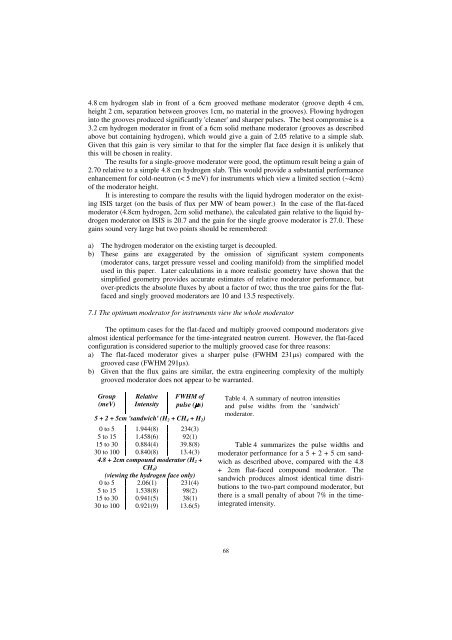Druck-Materie 20b.qxd - JUWEL - Forschungszentrum Jülich
Druck-Materie 20b.qxd - JUWEL - Forschungszentrum Jülich
Druck-Materie 20b.qxd - JUWEL - Forschungszentrum Jülich
You also want an ePaper? Increase the reach of your titles
YUMPU automatically turns print PDFs into web optimized ePapers that Google loves.
4.8 cm hydrogen slab in front of a 6cm grooved methane moderator (groove depth 4 cm,<br />
height 2 cm, separation between grooves 1cm, no material in the grooves). Flowing hydrogen<br />
into the grooves produced significantly 'cleaner' and sharper pulses. The best compromise is a<br />
3.2 cm hydrogen moderator in front of a 6cm solid methane moderator (grooves as described<br />
above but containing hydrogen), which would give a gain of 2.05 relative to a simple slab.<br />
Given that this gain is very similar to that for the simpler flat face design it is unlikely that<br />
this will be chosen in reality.<br />
The results for a single-groove moderator were good, the optimum result being a gain of<br />
2.70 relative to a simple 4.8 cm hydrogen slab. This would provide a substantial performance<br />
enhancement for cold-neutron (< 5 meV) for instruments which view a limited section (~4cm)<br />
of the moderator height.<br />
It is interesting to compare the results with the liquid hydrogen moderator on the existing<br />
ISIS target (on the basis of flux per MW of beam power.) In the case of the flat-faced<br />
moderator (4.8cm hydrogen, 2cm solid methane), the calculated gain relative to the liquid hydrogen<br />
moderator on ISIS is 20.7 and the gain for the single groove moderator is 27.0. These<br />
gains sound very large but two points should be remembered:<br />
a) The hydrogen moderator on the existing target is decoupled.<br />
b) These gains are exaggerated by the omission of significant system components<br />
(moderator cans, target pressure vessel and cooling manifold) from the simplified model<br />
used in this paper. Later calculations in a more realistic geometry have shown that the<br />
simplified geometry provides accurate estimates of relative moderator performance, but<br />
over-predicts the absolute fluxes by about a factor of two; thus the true gains for the flatfaced<br />
and singly grooved moderators are 10 and 13.5 respectively.<br />
7.1 The optimum moderator for instruments view the whole moderator<br />
The optimum cases for the flat-faced and multiply grooved compound moderators give<br />
almost identical performance for the time-integrated neutron current. However, the flat-faced<br />
configuration is considered superior to the multiply grooved case for three reasons:<br />
a) The flat-faced moderator gives a sharper pulse (FWHM 231µs) compared with the<br />
grooved case (FWHM 291µs).<br />
b) Given that the flux gains are similar, the extra engineering complexity of the multiply<br />
grooved moderator does not appear to be warranted.<br />
Group<br />
(meV)<br />
Relative<br />
Intensity<br />
FWHM of<br />
pulse (µµµµs)<br />
5 + 2 + 5cm 'sandwich' (H2 + CH4 + H2)<br />
0 to 5 1.944(8) 234(3)<br />
5 to 15 1.458(6) 92(1)<br />
15 to 30 0.884(4) 39.8(8)<br />
30 to 100 0.840(8) 13.4(3)<br />
4.8 + 2cm compound moderator (H2 +<br />
CH4)<br />
(viewing the hydrogen face only)<br />
0 to 5 2.06(1) 231(4)<br />
5 to 15 1.538(8) 98(2)<br />
15 to 30 0.941(5) 38(1)<br />
30 to 100 0.921(9) 13.6(5)<br />
Table 4. A summary of neutron intensities<br />
and pulse widths from the ‘sandwich’<br />
moderator.<br />
Table 4 summarizes the pulse widths and<br />
moderator performance for a 5 + 2 + 5 cm sandwich<br />
as described above, compared with the 4.8<br />
+ 2cm flat-faced compound moderator. The<br />
sandwich produces almost identical time distributions<br />
to the two-part compound moderator, but<br />
there is a small penalty of about 7% in the timeintegrated<br />
intensity.<br />
68

















